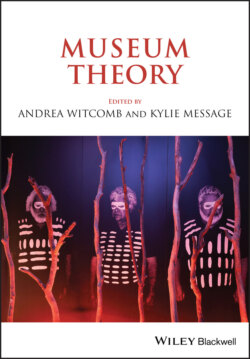Читать книгу Museum Theory - Группа авторов - Страница 53
Theory behaving badly
ОглавлениеThe need has arisen to complicate the prevailing notion of inclusivity in the context of the museum, and this can be facilitated, as suggested, by rupturing the strict boundaries that operate to define subjectivity. This is why a theoretical reconfiguration of how desire is generated is advantageous. In the ideological framing of critical theory, desire is understood as a lack, a law, and/or a structure of repression. But, as suggested, there is more to understanding desire, just as there are multiple assemblages that may be formed with the Mona Lisa. This is desire understood as an affective connection that operates prior to the emotional response that accords with any extant ideology in a representation, be this representation in an exhibition or any other text. This reconfiguration of desire is a shift from the viewer of an artwork as a knowing being to a state of becoming, a shift that moves analysis of encounters with museum objects from the certainty of “is” to “and … and … and …”
The attention given in museum theory to the rational, inclusive museum does not easily facilitate a critical approach to the rhizomatic museum. In the psychoanalytical and other dramas that are projected onto objects, what are advanced are meanings that are fixed in the past, in a cause-and-effect model of recognition that is based on a repetition of dogmatic images of thought. Unveiling the construction of dogma was the mission of Nietzsche who revealed that dogma or truth is a dominant perspective to explain human experience in a certain way; truth is a fiction with which we think about things in order to make meanings of the world. Gilles Deleuze’s work on difference, desire, and the rhizomatic connections between thoughts is a continuation of the Nietzschean project to reveal the illusory nature of the dogmatic images of our thought be this a thought of time as linear or of identity as fixed. It is this rhizomatic trajectory of thought that offers an expanded approach to encounters with objects of material culture in museums and hence the role of museums in affirming a progressive posthumanism.
In the context of theory on the museum, the chapter has been concerned with the complexity of affecting encounters in generating new ways of imagining interactions between human and nonhuman worlds. The space of new becomings will always benefit from a muting of subjectivity, a possibility affected through encounters with objects that do not operate within human notions of linear history and time. Prepersonal, precognitive affective intelligence is situated outside historical, linear time and is not limited to a common sense past, present, and future. Unfamiliar spaces and times have always been part and parcel of wondrous encounters with museum objects. Notwithstanding the rigor of critical analysis and the large and important body of work in museum studies since the advent of the new museology, the fictional notion of anarchical artifacts that cause havoc in the commonsense, rational museum excites us to the possibilities of our own transformation. After all, who wants a tree in their head?
